The production values are terrible. The acting is bad.
But this is a movie worth watching.
Set in the early 1980s, Latino follows a Chicano soldier recruited to train Nicaraguan counterrevolutionaries along the Honduras side of the border. They were called “contras.”
Whether the contras were a home grown group or one created and funded by the United States was a contentious issue in the 1980s.
Ronald Reagan, who was the U.S. president then, famously said, “I’m a contra, too.”
This movie must be viewed with an eye toward the world situation at the time: the cold war between the Soviet bloc and the free world was firmly entrenched. The United States was petrified of another communist country like Cuba cropping up in its back yard.
Also in the early 1980s, the International Court of Justice ruled against the United States for mining Nicaraguan harbors.
It was also filmed before Eugene Hasenfus was captured by the Sandinista government when his plane went down in Nicaragua and was accused of being a CIA operative.
 The Sandinistas, named after Augusto César Sandino who led the Nicaraguan resistance against the United States occupation of Nicaragua in the 1930s, came to power in Nicaragua in 1979. They defeated longtime dictator Anastasio “Tachito” Somoza Debayle.
The Sandinistas, named after Augusto César Sandino who led the Nicaraguan resistance against the United States occupation of Nicaragua in the 1930s, came to power in Nicaragua in 1979. They defeated longtime dictator Anastasio “Tachito” Somoza Debayle.
The movie was also filmed before the Iran-Contra Affair which, according to Wikipedia, “was a political scandal in the United States that came to light in November 1986. During the Reagan administration, senior Reagan administration officials secretly facilitated the sale of arms to Iran, the subject of an arms embargo. Some U.S. officials also hoped that the arms sales would secure the release of hostages and allow U.S. intelligence agencies to fund the Nicaraguan Contras.”
In Latino, the acting is heavy handed and the soundtrack is terrible.
It is also one-sided: the contras kill children and rape women while the Sandinistas are the true champions of the people.
But it is hard to remember things differently.
It has been said that the first casualty of war is truth and the war in Nicaragua was no different.
In the 1980s, pundits and politicians tried desperately to win favor for their positions on the war.
Were the Sandinistas Soviet stooges? Were they planning, with Cuban help, to allow the Soviet military to set up shop in Nicaragua?
Or were they freedom fighters who opposed injustice whether by the hand of Somoza or by the United States? Were they the heroes who redistributed land and wealth to better the lives of the Nicaraguan people?
One main problem faced by the Sandinistas was their lack of experience in governing. The skill set for mounting a revolution is very different from the one for ruling a country.
Some of the more memorable scenes in Latino show actual people, not actors, talk about the war. What they want is peace and prosperity.
While the Sandinistas were not perfect leaders, their revolution inspired people around the world.
Canadian singer-songwriter Bruce Cockburn summed up the exact time Somoza was overthrown in his song “Nicaragua,” which includes the lyrics: “In the flash of this moment/You’re the best of what we are/Don’t let them stop you now/Nicaragua.”
Latino is available to rent.
Murphy can be reached at: [email protected]